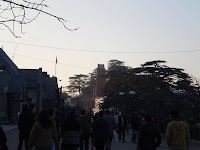
Azur vivace d’un espace
Ou chaque arbre se hausse
A la recherché de son âme.
Jules Supervielle
Around a year ago I made the following comments on this blog about Jakhoo forest in relation to Christ Chruch:
‘Although Christ Church is the icon of Shimla it is dwarfed by the mountains all around, the geography of Shimla mall soars up behind Christchurch like a wall which leads to Jakhoo peak, home of Hanuman. Now, Jakhoo temple can’t really be seen from the Mall, or the lift, unlike Christ Church, because it is hidden behind a covering of sacred deodars... Jakhoo then does not stand (as Christ Church does) proudly for all to see as a man made construction that reminds us of Divine creation, rather it sits engulfed in the Divinity of the natural world. As such it mirrors the mountains that are visible surrounding Shimla, many of them topped with temples whose beauty and serenity far surpasses that of Jakhoo in my opinion, but nevertheless operate in a similar way’.
How times change, now, ushered in by a movie star, Hanuman towers over the trees and looks down on the town below. So, my theory is clearly shot, but given this I now have questions for all my Shimla friends: how are people on the ground seeing this transition? Is the explicit branding of the forest landscape as the realm of Hanuman more favourable than the previous implicit (yet widely recognised association)? Is Hanuman now the focus of man’s tribute to Divinity in Shimla, not Christchurch? Is this a bold symbol of postcolonial identity, or simply a act of piety? Has the statue changed the character and feel of Shimla? What sort of visual dialogue does the statue have with Christ Church? Is it harmonious, hierarchical, or hostile?













